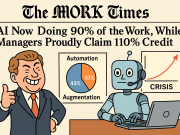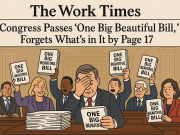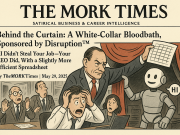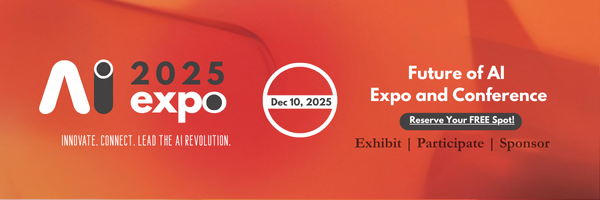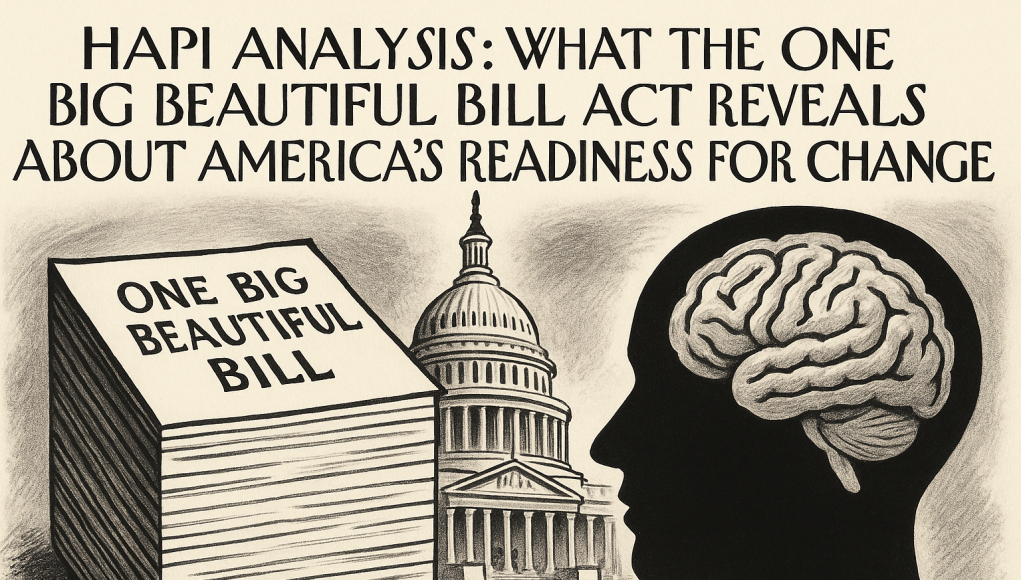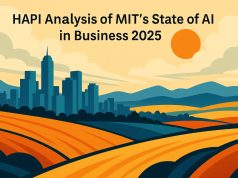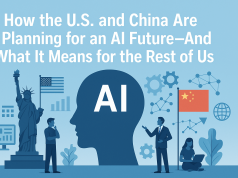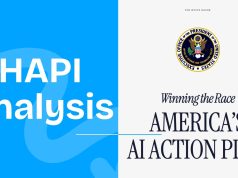Much like the ancient river systems that shaped entire civilizations without caring about kings or politics, some ideas cut through partisan noise and get to the bedrock of human progress. One such idea is adaptability – the quiet superpower behind human survival and success. And in today’s complex world, the ability to adapt isn’t just helpful; it’s existential.
That’s why we at HAPI — the Human Adaptability and Potential Index — are taking a good, data-driven look at one of the largest and most ambitious legislative efforts in recent memory: the One Big Beautiful Bill Act (OBBBA). No slogans. No spin. Just systems thinking, backed by a framework that measures how policies impact human adaptability across five vital dimensions.
What Is HAPI?
HAPI is not your average acronym in a sea of think-tank jargon. It’s a multidimensional index designed to assess how well individuals can adapt to change and grow over time. It tracks five core areas:
- Cognitive Adaptability – How we think, learn, and solve new problems.
- Emotional Adaptability – How we manage stress, stay resilient, and stay motivated.
- Behavioral Adaptability – How we change habits and respond to new norms.
- Social Adaptability – How we collaborate and communicate with others.
- Growth Potential – Our long-term capacity to learn, evolve, and contribute meaningfully.
Unlike traditional metrics (like IQ or degrees), HAPI doesn’t care just about what you know, but how fast you can learn, unlearn, and re-learn.
What Is OBBBA?
The One Big Beautiful Bill Act is, true to its name, big and ambitious. Spanning agriculture, education, defense, healthcare, energy, and even artificial intelligence policy, it’s a legislative omnibus designed to reshape how government interacts with work, industry, and public life.
Think of OBBBA as the legislative equivalent of a full ecosystem reboot. Its authors see it as a roadmap for national strength. We see it as an opportunity to ask a critical question:
Does this bill make Americans more adaptable, more capable, and more future-ready?
Why Analyze Policy Through HAPI?
Because policy shapes the environment in which human potential either thrives or withers. When a bill sets new education priorities, it determines whether the next generation is prepared for jobs that don’t yet exist. When it tweaks labor laws, it decides how easily someone can shift careers. When it alters access to healthcare or housing, it impacts stress levels and social stability — which in turn affect everything from emotional resilience to job performance.
Adaptability isn’t just personal. It’s systemic.
To put it simply: the more adaptable the citizen, the more resilient the society. And the better our policies align with human adaptability, the more likely we are to succeed as a nation — economically, socially, and ethically.
The Nonpartisan Promise
Let’s be clear: This series is not about picking political sides. If OBBBA were a person, we wouldn’t be interested in its fashion sense or Twitter history. We’re here to evaluate its impact on human adaptability – what it enables, what it inhibits, and how it prepares us for the shocks and surprises that lie ahead.
We’re treating the bill like a complex machine: inspecting the gears, not the brand logo.
Our guiding question: How does this policy architecture support (or undermine) the adaptability of American workers, families, and communities?
The Journey Ahead
In the blogs that follow, we’ll analyze OBBBA through each of HAPI’s five lenses:
- Cognitive Adaptability – Does the bill stimulate learning and innovation?
- Emotional Adaptability – Does it help people stay resilient in the face of uncertainty?
- Behavioral Adaptability – Does it support changes in habits, work, and life?
- Social Adaptability – Does it help us collaborate better as a nation?
- Growth Potential – Does it prepare us for long-term success?
Finally, we’ll wrap up with a summary scorecard and actionable insights for policymakers, educators, businesses, and communities.
One Last Metaphor…
The chameleon doesn’t survive because it’s strong or fast — but because it adapts. In an age of climate change, AI disruption, and global volatility, America’s future may well depend not on being the strongest or richest, but the most adaptable.
And that’s why we built HAPI. And that’s why we’re studying OBBBA.
Cognitive Adaptability and the Bill: Are We Stimulating Agile Minds?
“In the long history of humankind, those who learned to collaborate and improvise most effectively have prevailed.” — Charles Darwin
Introduction
In an era defined by rapid technological advancements and shifting economic landscapes, the ability to adapt cognitively—to learn, unlearn, and relearn—has become paramount. Cognitive adaptability encompasses our capacity to process information, solve problems, and embrace new ideas. As we examine the One Big Beautiful Bill Act (OBBBA), it’s essential to assess how its provisions impact this critical facet of human potential.
Understanding Cognitive Adaptability
Cognitive adaptability refers to the mental agility that enables individuals to navigate complex and changing environments. It’s the cornerstone of innovation, critical thinking, and lifelong learning. Policies that support education, research, and access to information play a significant role in fostering this adaptability.
OBBBA’s Impact on Cognitive Adaptability
Education Funding and Access
OBBBA proposes significant changes to higher education funding, including cuts to federal financial aid programs such as Pell Grants and student loans. These reductions could limit access to higher education, particularly for low-income students, thereby constraining opportunities for cognitive development and skill acquisition. newamerica.org+1insidehighered.com+1
Research and Innovation
The bill includes provisions that affect research funding and tax incentives for domestic research and development. While there are measures to encourage domestic research expenditures, the overall impact on innovation ecosystems remains uncertain, potentially affecting the nation’s capacity for scientific advancement. skadden.com+1facebook.com+1
Digital Infrastructure and Access
OBBBA’s stance on digital infrastructure investment is less clear. In an age where digital literacy is integral to cognitive adaptability, insufficient investment in broadband access and digital tools could exacerbate existing disparities, particularly in underserved communities.
HAPI Score: Cognitive Adaptability
Based on our analysis, we assign a HAPI Cognitive Adaptability Score of 5.2 out of 10 to OBBBA.
Score Breakdown:
- Education Access: The proposed cuts to financial aid programs may hinder access to higher education, limiting cognitive development opportunities.
- Research Support: While there are incentives for domestic research, the overall impact on innovation and knowledge creation is ambiguous.
- Digital Inclusion: The lack of clear investment in digital infrastructure could impede digital literacy and access to information.
Conclusion
Cognitive adaptability is essential for individuals and societies to thrive amid change. OBBBA’s current provisions present challenges to fostering this adaptability, particularly through reduced access to education and uncertain support for research and digital infrastructure. To build a resilient and innovative future, policies must prioritize and invest in the cognitive development of all citizens.
Are We Stimulating Agile Minds?
A Deep Dive into Cognitive Adaptability and the One Big Beautiful Bill Act
In 1879, Thomas Edison reportedly failed 1,000 times before successfully inventing the lightbulb. When asked if he felt like a failure, he replied, “I have not failed. I’ve just found 1,000 ways that won’t work.” That mindset — one of relentless learning and reframing of failure — is a classic case of cognitive adaptability in action.
Today, as we sift through the sweeping ambitions of the One Big Beautiful Bill Act (OBBBA), we ask: Does this bill foster the conditions needed for millions of Americans to think, learn, and adapt like Edison — or are we legislating ourselves into intellectual rigidity?
What Is Cognitive Adaptability?
Cognitive adaptability refers to our ability to adjust our thinking in response to new information, environments, or challenges. It’s how we learn new skills, pivot strategies, and think creatively under pressure. In neuroscience, it’s closely linked to neuroplasticity — the brain’s remarkable ability to reorganize itself by forming new neural connections.
In practical terms, cognitive adaptability is the skill behind a farmer learning to operate drones, a veteran retraining as a data analyst, or a teacher integrating AI into the classroom.
To nurture this capacity at scale, a society must invest in three pillars:
- Access to lifelong learning
- Support for innovation and research
- Equitable access to digital infrastructure
Let’s evaluate how OBBBA performs on each front.
1. Access to Lifelong Learning:
Does OBBBA Expand or Constrain Educational Mobility?
Education is the foundation of cognitive flexibility — not just at the K–12 level, but across a lifetime. Yet, OBBBA proposes substantial changes to federal student aid. Among them:
- A $1.5 billion cut in Pell Grant funding
- Tightened eligibility for federal student loans
- Reduction in public service loan forgiveness options
The Impact: These moves could significantly deter low-income and non-traditional learners from pursuing higher education or reskilling programs. At a time when workers must pivot careers multiple times over their lifetimes, such barriers constrain our national ability to think on its feet.
💡 Anecdote: During WWII, the U.S. passed the G.I. Bill — not just as a benefit, but as a national investment in mental capital. Veterans returned to school in droves, becoming engineers, scientists, and teachers. That one legislative act sparked a generation of inventors. If OBBBA is our 21st-century omnibus, does it honor that tradition?
2. Support for Research and Innovation:
Are We Fueling Curiosity and Creativity?
OBBBA includes several tax incentives for domestic research expenditures, and provisions that encourage defense-based technology transfer and applied research. However, it stops short of directly increasing civilian R&D budgets or creating new educational innovation funds.
The Result: This creates a fragmented research ecosystem — encouraging innovation in silos (like defense), but not necessarily in classrooms, public health, or grassroots science. Additionally, there’s no explicit support for interdisciplinary research — often the most fertile ground for breakthrough ideas.
🧬 Historical Context: Bell Labs, once hailed as the “idea factory,” produced the transistor, the laser, and information theory — all from publicly and privately funded basic research. Its success came from long-term thinking, not quarterly profits. OBBBA’s short-term incentives may not cultivate such environments.
3. Digital Infrastructure and Access:
Are We Creating Equal Opportunities for Digital Fluency?
Digital literacy is now as foundational as reading and arithmetic. Yet, OBBBA contains minimal emphasis on expanding broadband access or equipping public schools and libraries with 21st-century tools.
- No targeted funding to close the digital divide
- No mandates to ensure equitable access to AI or coding education
- No expansion of the E-rate program (which connects schools to broadband)
The Risk: In rural America and inner-city schools alike, millions still lack access to high-speed internet and devices. Without these, how can we expect students to develop the cognitive agility demanded by a digital world?
📱 Anecdote: In South Korea, the government’s 2004 “Cyber Korea” initiative connected 99.9% of schools to broadband and trained every teacher in IT within three years. The result? A digitally literate workforce that now leads in robotics and tech exports. OBBBA misses such moonshot potential.
HAPI Score: Cognitive Adaptability
🧠 Score: 5.2 / 10
Score Breakdown:
- Education Access: 4.5 Cuts to student aid and limited upskilling programs stifle mobility.
- Research Innovation: 6.0 Support exists in silos, but lacks a civilian innovation surge.
- Digital Inclusion: 5.0 Digital access is barely addressed, worsening the adaptability gap.
The Adaptability Gap: What’s Missing?
- Lifelong Learning Grants: Where are the “upskill scholarships” for displaced workers or 50+ professionals needing to pivot?
- AI & Tech Literacy for All: Where’s the investment in teaching AI literacy, not just building it?
- Community Learning Hubs: Where are the modern equivalents of the public library — now centers for coding, job training, and digital navigation?
Final Thoughts: Mind the Mind Gap
Cognitive adaptability isn’t a nice-to-have; it’s the competitive edge of modern nations. Yet OBBBA — for all its ambition — lacks a coherent strategy for cognitive empowerment. It inadvertently rewards the already-adaptable and under-resources those who need the most support to retool their minds.
We can’t build a resilient workforce on outdated tools. Without serious investments in mental agility, even the boldest bill may fall short of the future it tries to shape.
Emotional Adaptability and the One Big Beautiful Bill Act: Building Resilience or Adding Stress?
“It is not the strongest of the species that survives, nor the most intelligent, but the one most responsive to change.” — Charles Darwin
Introduction
In the intricate tapestry of human adaptability, emotional resilience stands as a cornerstone. It’s the capacity to navigate stress, recover from adversity, and maintain psychological well-being amidst change. As we examine the One Big Beautiful Bill Act (OBBBA), it’s imperative to assess how its provisions influence the emotional adaptability of individuals and communities.
Understanding Emotional Adaptability
Emotional adaptability encompasses the skills and resources that enable individuals to manage stress, cope with uncertainty, and maintain mental health. Key components include:
- Access to Mental Health Services: Availability and affordability of counseling, therapy, and psychiatric care.
- Social Support Systems: Community programs and networks that provide emotional and practical support.
- Economic Stability: Financial security that reduces stress and anxiety.
- Healthcare Coverage: Insurance policies that cover mental health treatments and services.
OBBBA’s Impact on Emotional Adaptability
1. Changes to Medicaid and Mental Health Coverage
OBBBA introduces significant alterations to Medicaid, including:
- Work Requirements: Imposing work mandates for Medicaid eligibility could lead to coverage loss for individuals unable to meet these criteria, potentially increasing stress and reducing access to mental health services.
- Funding Reductions: Proposed cuts to Medicaid funding may limit the availability of mental health programs, particularly in underserved areas.
These changes could exacerbate existing disparities in mental health care access, particularly affecting low-income populations who rely heavily on Medicaid for psychological services.
2. Health Savings Accounts (HSAs) and Mental Health Expenses
OBBBA expands the use of HSAs to cover certain wellness expenses, such as:
- Fitness and Exercise Programs: Allowing HSA funds to be used for physical activity expenses up to specified limits.
While promoting physical wellness can indirectly benefit mental health, the reliance on HSAs may not effectively address the needs of individuals without the financial means to contribute to these accounts, thereby limiting the reach of such provisions.
3. Community-Based Mental Health Initiatives
The bill lacks substantial investment in community-based mental health programs, which are crucial for:
- Early Intervention: Identifying and addressing mental health issues before they escalate.
- Crisis Response: Providing immediate support during mental health emergencies.
- Ongoing Support: Offering continuous care and resources for individuals with chronic mental health conditions.
The absence of funding for these initiatives may hinder the development of resilient communities capable of supporting their members’ emotional well-being.
HAPI Score: Emotional Adaptability
🧠 Score: 4.8 / 10
Score Breakdown:
- Access to Mental Health Services: 4.0 Reductions in Medicaid funding and the introduction of work requirements may decrease access to essential mental health services.
- Social Support Systems: 5.0 The bill does not significantly invest in community-based programs that provide emotional support.
- Economic Stability: 5.5 While some provisions aim to promote financial security, the overall impact on reducing stress and anxiety is limited.
- Healthcare Coverage: 4.5 Changes to Medicaid and the reliance on HSAs may not adequately support mental health coverage for vulnerable populations.
Conclusion
Emotional adaptability is vital for individuals and societies to thrive amidst change. OBBBA’s current provisions present challenges to fostering this adaptability, particularly through reduced access to mental health services and insufficient support for community-based programs. To build a resilient and emotionally adaptable society, policies must prioritize mental health care accessibility and invest in supportive community infrastructures.
Behavioral Adaptability and the One Big Beautiful Bill Act
Can Policy Help Us Change Our Habits When It Matters Most?
“The chains of habit are too light to be felt until they are too heavy to be broken.” — Warren Buffett
Imagine a salmon navigating upstream — zigzagging past rocks, adjusting to rapids, avoiding bears — not because it enjoys struggle, but because it’s wired to adapt its behavior to reach home. Humans aren’t much different. Except instead of rivers, we’re navigating tax forms, job markets, energy bills, and healthcare plans.
The real question is: Does our legislation — particularly the One Big Beautiful Bill Act (OBBBA) — help or hinder that behavioral adaptability?
Let’s unpack this.
What is Behavioral Adaptability?
Behavioral adaptability is the ability to adjust daily routines, choices, and actions in response to changing environments. It’s the human capacity to:
- Switch careers when a job is automated
- Choose public transport over a personal vehicle
- Follow new health guidelines during a pandemic
- Adopt sustainable energy at home
In this light, good policy doesn’t just direct behavior — it empowers it. Think nudges, incentives, and scaffolds. The question becomes: Does OBBBA make it easier or harder for individuals to evolve their habits for a better future?
Let’s Talk Policy Mechanisms That Influence Behavior
There are generally three types of policy levers that influence behavioral change:
- Incentives and Disincentives – Tax breaks, penalties, subsidies
- Structural Supports – Access to tools, programs, services
- Norm Setting – Public signals about desirable behavior
So how does OBBBA stack up in each area?
1. Incentives and Disincentives: Do They Nudge Smart Behavior?
✅ Some Progress:
- Energy Savings: OBBBA proposes expanded tax credits for energy-efficient home upgrades and electric vehicle (EV) purchases. These incentives can encourage more sustainable behaviors among middle- to upper-income homeowners.
❌ But With Gaps:
- Workforce Shifts: The bill limits some retraining and educational credits, which makes career transitions more difficult — especially for workers displaced by automation or energy transitions.
- Health Behavior: Minimal direct incentives for preventive health or nutrition behaviors, aside from cuts to the SNAP education programs.
📝 Historical Analogy: During WWII, Americans were incentivized to conserve fuel and grow “victory gardens.” Behavior was shaped not just by propaganda, but by rations, tools, and pride. OBBBA offers tax carrots but very few sticks — and no real narrative push.
2. Structural Supports: Can People Realistically Adapt?
✅ Some Supports:
- Childcare Provisions: The bill does support expansion of childcare services in some areas, helping more people (especially women) return to work or school — a key enabler of new habit formation.
❌ Major Omissions:
- Digital Access: No significant investment in broadband infrastructure or digital inclusion initiatives, making it harder for rural or lower-income Americans to engage in modern work and education habits.
- Transportation Alternatives: The bill underplays investments in mass transit, limiting behavioral shifts away from car dependency in urban settings.
- Work Support Structures: Without robust career coaching or job placement systems, behavioral pivots become isolated efforts rather than supported transitions.
📊 Case Study: Singapore’s SkillsFuture initiative combines subsidies with structured guidance — making behavioral change less like swimming upstream and more like hopping on a raft with a map. OBBBA? More like handing people a paddle and wishing them luck.
3. Norm Setting: What Message Is This Bill Sending?
❌ Fragmented Signals:
OBBBA’s provisions, while numerous, don’t convey a cohesive behavioral narrative. There’s no overarching message like:
- “We’re preparing you for a clean energy economy.”
- “We’ll support your career pivots with guidance and grants.”
- “Community health is a shared priority, and here’s how we’re investing in it.”
When policies pull in different directions — e.g., cutting SNAP education while expanding EV subsidies — citizens get mixed signals. Behavioral change thrives in clarity. OBBBA currently lacks that.
HAPI Score: Behavioral Adaptability
🔄 Score: 4.7 / 10
Score Breakdown:
- Incentives: 5.5 Some good on energy behaviors, but too narrow.
- Supports: 4.0 Missing infrastructure for digital and transit shifts; underpowered retraining tools.
- Norms: 4.5 No coherent behavioral call-to-action or national narrative.
What’s the Adaptability Gap?
- Missing Reskilling On-Ramps: There’s no “habit-friendly” infrastructure for people who need to reinvent their careers.
- Low-Tech, High-Impact Interventions Ignored: Tools like behavioral coaching, decision aids, and peer mentoring — proven in studies to influence change — are absent.
- Underused Nudge Architecture: Behavioral economics tells us how to structure choices (defaults, friction, timing), but OBBBA seems unaware of the science.
Final Thoughts: Fish Need Water. People Need Structure.
Behavioral change doesn’t happen in a vacuum. It’s shaped by context, tools, timing, and nudges. OBBBA offers some thoughtful incentives — particularly in energy and childcare — but fails to provide a cohesive ecosystem for real behavior change.
If we want citizens to evolve their habits with the changing tides, we must build policy environments that act more like gently flowing rivers than bureaucratic obstacle courses.
Social Adaptability and the One Big Beautiful Bill Act
Are We Building Communities That Can Change Together?
“If you want to go fast, go alone. If you want to go far, go together.” — African Proverb
In the intricate dance of societal progress, the ability of communities to adapt collectively is paramount. Social adaptability—the capacity of groups to adjust, collaborate, and thrive amidst change—is the glue that binds individual efforts into cohesive, resilient societies. As we examine the One Big Beautiful Bill Act (OBBBA), it’s essential to assess how its provisions influence this collective adaptability.
Understanding Social Adaptability
Social adaptability refers to the mechanisms through which communities:
- Foster Collaboration: Encouraging cooperative efforts across diverse groups.
- Promote Inclusivity: Ensuring all members have access to resources and opportunities.
- Support Collective Resilience: Building systems that allow communities to withstand and rebound from challenges.
Policies that enhance social adaptability typically invest in:
- Community Development Programs: Initiatives that strengthen local institutions and networks.
- Inclusive Infrastructure: Facilities and services accessible to all community members.
- Education and Workforce Training: Programs that prepare diverse populations for evolving economic landscapes.
OBBBA’s Impact on Social Adaptability
1. Community Development and Support
OBBBA proposes significant cuts to programs like the Supplemental Nutrition Assistance Program (SNAP) and Medicaid, which have historically played crucial roles in supporting low-income communities. Reducing these safety nets may strain community resources, leading to increased disparities and weakening the social fabric that fosters collective adaptability.
2. Infrastructure and Accessibility
The bill’s emphasis on reducing federal spending extends to infrastructure projects, potentially limiting investments in public transportation, broadband expansion, and community centers. Such limitations can hinder connectivity and access to essential services, disproportionately affecting rural and underserved urban areas, and impeding their ability to adapt to economic and technological shifts.
3. Education and Workforce Development
While OBBBA includes provisions for expanding 529 education savings accounts and making certain tax credits permanent, it also introduces stricter eligibility requirements for Pell Grants and eliminates subsidized federal student loans. These changes could reduce access to higher education and vocational training for many, particularly those from marginalized communities, thereby limiting collective upskilling and adaptability. waysandmeans.house.gov
HAPI Score: Social Adaptability
🤝 Score: 4.3 / 10
Score Breakdown:
- Community Development: 4.0 Cuts to essential support programs may erode community resilience.
- Infrastructure and Accessibility: 4.5 Limited investment in inclusive infrastructure hampers connectivity and access.
- Education and Workforce Development: 4.5 Restrictive changes to education funding could impede collective skill advancement.
Bridging the Social Adaptability Gap
To enhance social adaptability, policies should:
- Invest in Community Programs: Strengthening local institutions that provide support and foster collaboration.
- Enhance Infrastructure: Ensuring equitable access to transportation, internet, and public spaces.
- Support Inclusive Education: Expanding access to affordable education and training programs for all demographics.
Conclusion
Social adaptability is the cornerstone of a resilient and progressive society. While OBBBA aims to streamline federal spending and promote economic growth, its current provisions may inadvertently undermine the collective capacity of communities to adapt and thrive. For a nation to move forward cohesively, policies must nurture the very networks and systems that enable communities to evolve together.
Growth Potential and the One Big Beautiful Bill Act
Does This Bill Plant Seeds for Tomorrow’s Workforce?
“The best time to plant a tree was 20 years ago. The second-best time is now.” — Chinese Proverb
Every farmer knows that good soil, clean water, and patient stewardship produce the best harvest. The same applies to human development. To unlock human potential — not just for today but for the decades ahead — policy must be both visionary and grounded.
In this final dimension of the Human Adaptability and Potential Index (HAPI), we examine how well the One Big Beautiful Bill Act (OBBBA) supports long-term growth potential — the ability of individuals, industries, and society to evolve over time.
What Is Growth Potential?
Growth potential is the trajectory of adaptability. It’s not about where someone is now, but where they could go with the right tools, opportunities, and support systems. It blends:
- Learning Agility – Can you improve quickly with feedback?
- Upward Mobility – Can your environment help you rise?
- Skill Relevance – Are you equipped for future jobs, not just today’s?
In policy terms, it means: Is the government investing in people the way it invests in infrastructure?
1. Future-Ready Education:
Are We Training for 2025 or 1995?
❌ Misalignment in Priorities
OBBBA imposes tighter restrictions on Pell Grants, eliminates subsidized loans, and reduces public education support in several forms — even as the bill claims to prepare Americans for a competitive future.
While some tax incentives are retained for 529 education accounts, these tools mostly benefit wealthier families already positioned for growth.
Missed Opportunity: There’s minimal investment in vocational upskilling, STEM education, or AI and digital fluency programs — the very areas driving 21st-century labor markets.
📚 Anecdote: Germany’s dual education system combines traditional learning with vocational apprenticeships, producing one of the most future-ready workforces in the world. OBBBA, in contrast, treats learning as a static phase of youth — not a continuous process.
2. Economic Mobility and Incentives
Does the Ladder Have Rungs?
✅ Some Signals of Support
- The bill encourages small business formation through tax simplification and investment incentives.
- It maintains certain income tax thresholds that can offer relief to middle-income earners.
❌ But the Ladder is Steep
- No comprehensive framework for gig economy workers or contractors who lack traditional job security or benefits.
- Limited funding for entrepreneurship incubators or innovation accelerators in underserved regions.
Bottom Line: Growth requires risk-taking, and risk-taking needs a safety net. OBBBA pulls back on some of those nets without replacing them with ladders.
3. Health, Housing, and Climate Resilience
Do People Have the Foundations for Growth?
❌ Fragile Foundations
- Cuts to Medicaid and housing support weaken the basic platform from which people launch long-term goals.
- Environmental provisions reduce investment in clean energy transitions, limiting long-term job creation in sustainable industries.
🌱 Context: The GI Bill not only paid for veterans’ tuition — it guaranteed affordable housing and healthcare access. It treated growth potential as holistic. OBBBA’s reductions in these areas may make it harder for many to even begin climbing.
HAPI Score: Growth Potential
📈 Score: 4.6 / 10
Score Breakdown:
- Education and Lifelong Learning: 4.0 Higher barriers to entry, limited future-skills investment.
- Economic Mobility: 5.0 Supportive for some, but limited by exclusions and lack of safety nets.
- Foundational Stability: 4.5 Health and housing cuts reduce security from which to grow.
The Potential Gap: What’s Holding Us Back?
- No National Reskilling Strategy: The bill lacks a plan for lifelong learning or rapid reskilling amid AI disruption.
- Underinvestment in Youth and Early Childhood: No meaningful new investments in Head Start, early literacy, or first-generation college access.
- No Holistic View of Human Growth: Real growth is physical, emotional, social, and intellectual. OBBBA fragments these areas instead of weaving them together.
Conclusion: Are We Planting for the Future?
Growth potential is not just a buzzword — it’s a measure of national competitiveness. While OBBBA includes provisions that support business and reduce government complexity, it fails to create a robust architecture for developing human capital across generations.
If the future is a garden, this bill waters some plants, but leaves the soil dry for most.
The Verdict on the One Big Beautiful Bill Act
What OBBBA Gets Right, Where It Misses, and How We Get to 10/10
“A society grows great when old men plant trees whose shade they know they shall never sit in.” — Greek Proverb
After six deep dives into the dimensions of human adaptability — cognitive, emotional, behavioral, social, and growth potential — one thing is clear: The One Big Beautiful Bill Act (OBBBA) is ambitious. But ambition without adaptability is architecture on sand.
So let’s bring this all together. Not to score a bill for its ideology, but to evaluate its real-world capacity to prepare America for change.
🔚 Final Composite Score: 4.7 / 10
Let that sink in: A bill affecting nearly every sector of American life scores under 5 on our national adaptability meter.
What’s Missing: The Root of the Adaptability Gap
1. Lifelong Learning Infrastructure
The future belongs to those who can pivot — and fast. Yet OBBBA guts or underfunds the very tools people need to reskill and reinvent.
No universal access to short-term, industry-aligned upskilling. No funding for AI, green tech, or digital inclusion in education systems.
Fix: National Reskilling Guarantee. Free or subsidized training for any worker whose job is threatened by tech or transition.
2. Community as a System, Not a Buzzword
Strong workers build strong communities, and strong communities support strong workers. OBBBA forgets the reciprocity.
Cuts to SNAP, Medicaid, and local development programs undermine community resilience. Little support for civic infrastructure, broadband, or local innovation hubs.
Fix: Civic Infrastructure Stimulus — invest in libraries, community centers, local tech labs. Make adaptability communal, not individual.
3. Behavioral Guidance with Dignity
Behavior doesn’t change by decree. It shifts through design: nudges, role models, smart defaults.
OBBBA provides some tax incentives (e.g. EVs), but offers no human-centered design in public systems. It penalizes non-compliance more than it rewards growth.
Fix: Apply behavioral economics at scale. Make it easier for people to make better choices — financially, socially, environmentally.
4. Emotional and Mental Resilience Support
You can’t adapt if your nervous system is in survival mode.
OBBBA rolls back access to mental health support via Medicaid changes. No investment in national stress reduction infrastructure or community mental health response.
Fix: Mental Resilience Act — expand access to trauma-informed care, community counselors, and stress education in schools and workplaces.
5. Narrative Leadership
Policy isn’t just paperwork. It’s story. OBBBA lacks a coherent message about the future it wants to build.
No moonshot. No call to action. Just pages of provision without inspiration.
Fix: Frame adaptability as America’s next great project — like the Apollo mission, the Internet buildout, or the GI Bill. Build policy that tells a story of inclusive growth.
What Would Make OBBBA a 10/10?
If OBBBA truly aimed for maximal national adaptability, it would include:
- Universal Access to Digital Skills and Tools
- Incentives for Personal Reinvention, Not Just Corporate Investment
- Mental Health Infrastructure Embedded in Every Community
- Place-Based Support for Rural and Urban Transitions
- A National Narrative of Empowerment, Not Austerity
Imagine a version of OBBBA that made every American feel like they had a map, a mentor, and a mission — and the support to pursue it.
That’s what 10/10 looks like.
Final Thoughts: Adaptability Is Not Optional
We don’t live in a time of stability. Climate change, AI disruption, economic shocks — these are not hypotheticals. They are here. The question isn’t whether we change, but how well we do it.
OBBBA, as it stands, is a sweeping effort that touches many systems but misses the heart of what makes systems work: people who can adapt, together.
We hope this HAPI-based review reminds policymakers, educators, business leaders, and community organizers that the next great American asset is not oil or data — it’s human adaptability.
Let’s build bills that unlock it.
Read more A Funny take on OBBBA
For Tips and suggestions Contact











